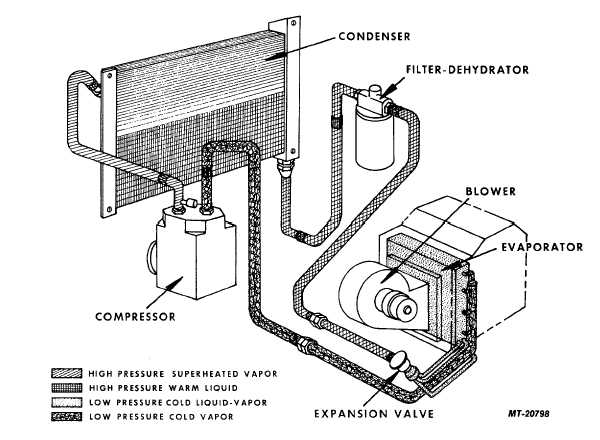|
| |
TRUCK SERVICE MANUAL
TM 5-4210-230-14&P-1
BODIES AND CABS
Fig. 18 Refrigerant Flow Through Air Conditioning System
AIR CONDITIONING PROCESS
Operation of the cab air conditioner is basically the
same as any mechanical refrigeration system, such as the
familiar home refrigerator.
The air conditioning process is a cycle in which the
refrigerant (heat absorbing agent) is propelled through a
closed system to an area where is absorbs heat from the cab
and is then carried to a point where the heat is dissipated to
the atmosphere. Let's follow the course of the refrigerant
through the various components of the air conditioning
system (Fig. 18).
The compressor draws refrigerant vapor from the
evaporator and compresses it to high pressure. The
temperature
of
the
vapor
is
increased
considerably
(superheated) by the compression process. Compressing the
refrigerant raises the temperature at which it will condense to
liquid. In fact it is raised so high that the vapor under
pressure can be cooled sufficiently to condense by a flow of
air at normal outside temperatures.
The compressed and superheated vapor flows into
the condenser. The air blowing across the condenser fins
removes the heat from the refrigerant causing it to condense
back to liquid.
Upon leaving the condenser, the liquid refrigerant,
under high pressure, is forced into the filter-dehydrator where
the drier agent removes any moisture from the refrigerant.
The expansion valve controls the flow of liquid
refrigerant into the evaporator. As the refrigerant passes the
expansion valve, pressure is reduced suddenly and it
vaporizes and expands.
The expansion valve is controlled by a temperature
sensing bulb and capillary tube attached to the outlet of the
evaporator. If the temperature of the vapor leaving the
evaporator becomes too low, the gas in the bulb contracts.
This lowers the pressure on the diaphragm and allows spring
pressure to close the valve, reducing the flow of refrigerant
into the evaporator. If the temperature of the vapor leaving
the evaporator increases, the gas within the bulb expands
and increases the pressure above the diaphragm in the
expansion valve. This action opens the valve to admit more
refrigerant into the evaporator and increases the cooling
effect.
CTS-2731 Page 12
PRINTED IN UNITED STATES OF AMERICA
|

